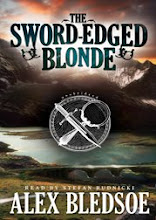"Dark Jenny is a fast-paced mystery with plenty of action; it’s also intelligent, original, and satisfyingly chiaroscuro."
You don't encounter the word "chiaroscuro" every day, and several readers asked me what it meant. Quoting from Webster, it's a "pictorial representation in terms of light and shade without regard to color." In other words, it's the use of darkness to let you see the light, and vice versa.
I first encountered the term with regards to one of my favorite genres, film noir. It's a great example of turning a flaw into an asset. Many of these movies were shot on very low budgets, which often meant cheap sets. To disguise this, the cinematographers would keep the sets dark, so that their flaws were hidden. Many of these same cinematographers, and the directors they worked for, were also expatriates from Nazi Germany, which meant they learned their craft during the Weimer Republic days of the great Expressionist films like M, Nosferatu, Metropolis and The Golem. This meant that not only did they know how to light for darkness, so to speak, but they knew why.

Peter Lorre in M. The film is actually shot in this weird vertical aspect ratio.
Chiaroscuro thrived in black and white film noir. Witness the use of shadows during the fist fight in Out of the Past, or the scene between Jonesy and Canino in The Big Sleep with only their dark silhouettes on the frosted glass. Watch the way Mike Mazurki appears behind Dick Powell in Murder, My Sweet. You could spend the day listing scenes that apply.

Dick Powell and Mike Mazuski in Murder, My Sweet.
So how does such a visual term translate to prose, specifically to the world of Eddie LaCrosse? It's a modification of the "innocent abroad" trope, in which the moral status of various characters (i.e., their shades of darkness) are made plain against the spiritual and moral purity of the innocent main character. Treasure Island, for example, uses the boy Jim Hawkins as the moral yardstick against which all the other characters are measured.
But in crime and mystery, it goes a step further, in that it allows the reader to interpret not just the people but the world. Raymond Chandler famously said of his genre, "Down these mean streets a man must go who is not himself mean, who is neither tarnished nor afraid." In other words, he is the light going down the streets of darkness (no Biblical reference intended).

Harrison Ford and Sean Young in Blade Runner, which transposes chiaroscuro to the future.
That's how I see Eddie, and how I hope he's used in the stories. He's not mean in the sense Chandler uses the word (both vicious and ignoble), but he has been in the past, and he knows how easy it is to cross that line. He's tarnished, certainly, but he's in the process of polishing that away. And he's not afraid of the walk, although he has sense enough to be scared of what might live in the shadows he passes through.
Without his light, we could never see what dwells in the shadows. And without the shadows, we'd never know the value of the light, of the hero, of our guy Eddie. And that's how chiaroscuro fits into the world of Eddie LaCrosse.














No comments:
Post a Comment